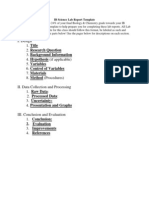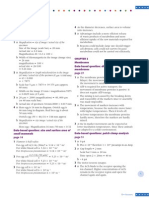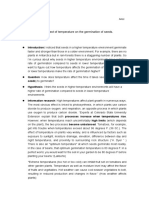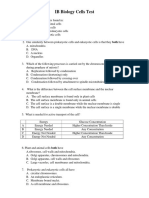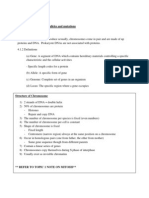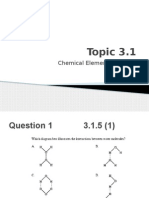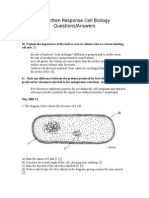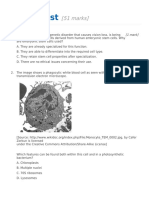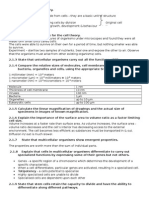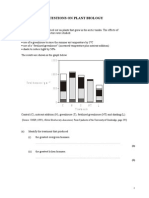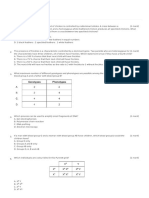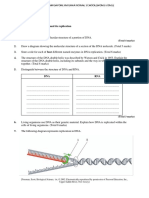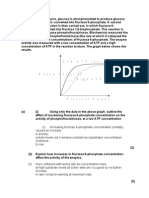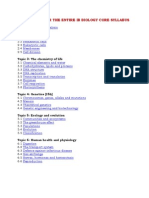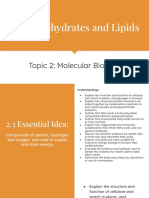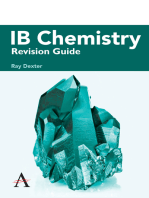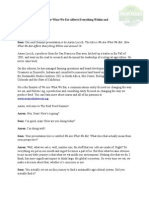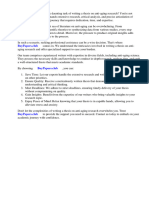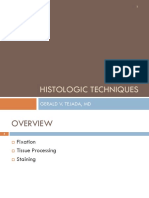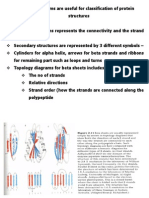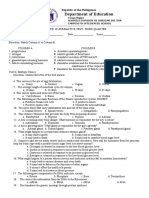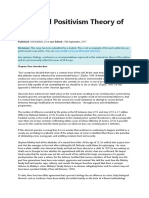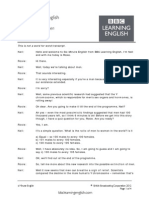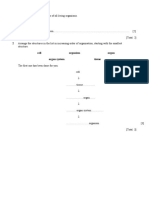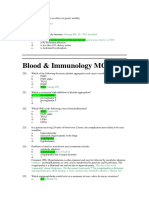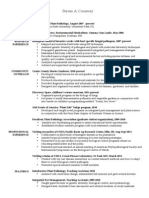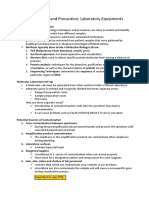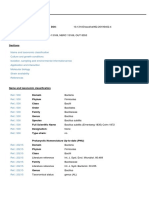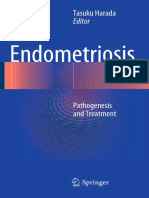Biology Ib Questions Cells Document
Biology Ib Questions Cells Document
Uploaded by
Cosima Francesca ScheiblerCopyright:
Available Formats
Biology Ib Questions Cells Document
Biology Ib Questions Cells Document
Uploaded by
Cosima Francesca ScheiblerOriginal Description:
Original Title
Copyright
Available Formats
Share this document
Did you find this document useful?
Is this content inappropriate?
Copyright:
Available Formats
Biology Ib Questions Cells Document
Biology Ib Questions Cells Document
Uploaded by
Cosima Francesca ScheiblerCopyright:
Available Formats
BIOLOGY IB Questions CELLs 2.1 cell thory 1.
Discuss possible exceptions to cell theory (4) All organisms are made up of cells,(microscopy) but there are some exceptions: - Bone consist of much inorganic substances and only a low percentage consist of cells so it is an unusual tissue. - Muscle cells are much larger then normal cells and are multi- nucleate, also fungal hyphae is multi- nucleate but also dividing walls and so does not consist of individual cells. - Unicellular organisms can be considered acellular as they are larger than a typical cell. Some tissues and organs contain large amounts of extracellular material so the statement that all organisms are made up of living cells has exeptions. Cell theory: all living organisms consist of cells (microscopy)The cell is the smallest unit of life; organelles could not live on their own after a longer period of time. All cells arise from pre- existing cell by cell division (swan necked flask by Louis Pasteur) 2. Explain how the surface area to volume ratio influences cell sizes. (6) when the cell size increases surface area and volume increases, the volume increases more therefore the ratio of surface area to volume ratio decreases The more volume a cell has the rate at which materials are produced and used increases. The surface area, so the membrane, must be large enough to absorb nutrients such as oxygen and other substances needed for the cell. The surface area, membrane, must also be large enough to excrete waste products. The size of the surface area affects the rate at which substances can enter and leave the cell. If the cell is to big and the volume compared to surface area is to big it will take too long for substances to diffuse in and out of the cell. Especially excretory products would take too long to be eliminated Therefore the cell will divide when it has reached a certain size.
3. Explain differentiation of cells in multicellular organisms. (6) This the way in which the cells in a multicellular organism develop in a certain way to carry out a specific function. Therefore the cells become specialised. All of the cells in a multi-cellular organism have the exact same set of genes.
A certain combination of genes is activated and this causes the cell to differentiate in a certain way. A red blood cell is an example of a specialised cell. It is specialised to transport oxygen so the genes for haemoglobin production gets activated in this cell whereas the gene for nucleus production gets switched off. A group of specialised cells is called a tissue. The mechanism by which cells differentiate is not fully understood but it may have something to do with the position of the cell in the ball, cell to cell signalling or hormones.
4. Outline one therapeutic use of stem cells (8) stem cells retain the capacity to divide and have the ability to differentiate into all types of cells. Stem cells can be taken from the placenta, umbilical cord and some adult tissues. New technology has developed for replacing dysfunctional cells with healthy cells. The stem cells have to be identified and are grown in controlled conditions. Biochemical are developed to cause the stem cell to differentiate into desired cells. The cells are now placed into the patients tissue so they function with the bodys natural cells. The immune system has to be supressed so the implanted cells are not rejected.
Examples: - retinal cells replace dead cells in retina for diseases such as glaucoma - new skin cells to treat burn victims - nerve tissue to help treat spinal injuries - collect stem cells from umbilical chord to treat leukaemia 2.2 Prokaryotic cells 5. Escherichia coli is a unicellular organism. Outline the functions of each of the structures in this cell. (8) An Escherichia coli contains different organelles to carry out processes required for life. The cell wall protects the cell from damage and prevents the cell from bursting The plasma membrane carries out active transport and controls what goes in and out of the cell. Cytoplasm contains enzymes that carry out metabolic reactions Pili are used to connect bacterial cells to other bacterial cells.
Flagella are used for movement of the prokaryotic cell. 70s ribosomes synthesise proteins. The naked DNA is located in the nucleoid, which initiates reproduction/ binary fission. The naked DNA controls the cell structure and functions such as disease resistance.
6. http://www.scribd.com/doc/56007215/Previous-IB-Exam-Essay-Questions
You might also like
- IB Biology Cells Past Paper QuestionsDocument9 pagesIB Biology Cells Past Paper Questionsemy414790% (10)
- Vijaya Lakshmi PDFDocument2 pagesVijaya Lakshmi PDFshyamchepurNo ratings yet
- IB Biology: Topic 2 Past Exam Data QuestionsDocument13 pagesIB Biology: Topic 2 Past Exam Data QuestionsJune Chow100% (2)
- T1-2 T (IB Biology Topic 2 Question Bank)Document32 pagesT1-2 T (IB Biology Topic 2 Question Bank)Kunakorn Kunthamas50% (2)
- IB Biology Questions - Paper 2 Topic 5 QuestionsDocument14 pagesIB Biology Questions - Paper 2 Topic 5 QuestionsIB Blueprint0% (1)
- IB Biology Lab ManualDocument87 pagesIB Biology Lab Manualethioboy23100% (4)
- IB Biology HL NotesDocument154 pagesIB Biology HL NotesBobby McFerrin100% (2)
- IB Biology Study NotesDocument134 pagesIB Biology Study Noteshdpham100% (25)
- Digestion Questions Ib TESTDocument11 pagesDigestion Questions Ib TESTJohn Osborne100% (2)
- IB Biology Lab Report TemplateDocument6 pagesIB Biology Lab Report TemplatebigbuddhazNo ratings yet
- IB Biology Questions - Paper 2 Topics 1 + 2 QuestionsDocument11 pagesIB Biology Questions - Paper 2 Topics 1 + 2 QuestionsIB Blueprint100% (1)
- IB Biology Questions - Paper 1 Topic 6 QuestionsDocument36 pagesIB Biology Questions - Paper 1 Topic 6 QuestionsIB Blueprint95% (20)
- IB Biology Questions - Topic 4 Paper 1 QuestionsDocument23 pagesIB Biology Questions - Topic 4 Paper 1 QuestionsIB Blueprint67% (3)
- Previous IB Exam Essay QuestionsDocument58 pagesPrevious IB Exam Essay QuestionsDah Lin J92% (12)
- IB Biology Questions - Paper 1 Topics 1 + 2 QuestionsDocument28 pagesIB Biology Questions - Paper 1 Topics 1 + 2 QuestionsIB Blueprint79% (14)
- International Baccalaureate (IB) Database Questions Biology HLDocument20 pagesInternational Baccalaureate (IB) Database Questions Biology HLTonia von HugoNo ratings yet
- IB QUESTIONS From PAST PAPERSDocument9 pagesIB QUESTIONS From PAST PAPERSJohn Osborne100% (2)
- IB Bio IADocument16 pagesIB Bio IAjunyiwuNo ratings yet
- Cell Test IB BIO HL 123Document7 pagesCell Test IB BIO HL 123AdamNo ratings yet
- IB Biology Syllabus Points With Mark SchemeDocument29 pagesIB Biology Syllabus Points With Mark Schemeemy4147100% (4)
- IB Biology SL GeneticsDocument8 pagesIB Biology SL GeneticsAliciaChing24No ratings yet
- IB Biology Questions - Topic 3 Paper 1 QuestionsDocument32 pagesIB Biology Questions - Topic 3 Paper 1 QuestionsIB Blueprint100% (2)
- O Level Biology Practice Questions And Answers: Heredity And Molecular GeneticsFrom EverandO Level Biology Practice Questions And Answers: Heredity And Molecular GeneticsNo ratings yet
- Introduction To Cells (1.1) :: The Cell TheoryDocument65 pagesIntroduction To Cells (1.1) :: The Cell Theoryelvira sta.mariaNo ratings yet
- HL IB BiologyDocument3 pagesHL IB Biologycoolcat132100% (2)
- IB Biology Study NotesDocument134 pagesIB Biology Study NotesManav Parikh100% (4)
- Ib Bio Previous IB Exam Essay QuestionsDocument34 pagesIb Bio Previous IB Exam Essay Questionssrahimi@verizon.net100% (3)
- IB Biology Internal Assessment GuideDocument7 pagesIB Biology Internal Assessment GuideEweliniuks100% (7)
- IB Written Response Cell Biology AnswersDocument5 pagesIB Written Response Cell Biology AnswersJulide Catherine Yanikomeroglu100% (1)
- Ib Biology SLDocument68 pagesIb Biology SLShelley Lima100% (1)
- Topic 1 TestDocument11 pagesTopic 1 Testrania samirNo ratings yet
- IB Biology Exam NotesDocument38 pagesIB Biology Exam NotesNica Calvert94% (17)
- IB Biology Questions - Paper 2 Topic 6 QuestionsDocument18 pagesIB Biology Questions - Paper 2 Topic 6 QuestionsIB Blueprint100% (4)
- Ib Biology Topic 1 CellsDocument10 pagesIb Biology Topic 1 Cellswee100% (1)
- Biology HL Exam QuestionsDocument120 pagesBiology HL Exam Questionsfasd100% (1)
- 4 Data-Style Questions On Plant BiologyDocument13 pages4 Data-Style Questions On Plant BiologyJohn Osborne100% (2)
- T3-1 T Biology Question BankDocument31 pagesT3-1 T Biology Question BankKunakorn KunthamasNo ratings yet
- IB Biology Questions - Paper 2 Topic 4 QuestionsDocument9 pagesIB Biology Questions - Paper 2 Topic 4 QuestionsIB BlueprintNo ratings yet
- IB Biology Plant ScienceDocument26 pagesIB Biology Plant Sciencealekzi67% (3)
- IB BIOLOGY TOPIC 1 QuestionsDocument3 pagesIB BIOLOGY TOPIC 1 QuestionsSarah Mason100% (1)
- IB Biology HL Essay QuestionsDocument71 pagesIB Biology HL Essay Questionssms100% (2)
- IB Biology Questions - Paper 2 Topic 3 QuestionsDocument19 pagesIB Biology Questions - Paper 2 Topic 3 QuestionsIB Blueprint100% (3)
- IB Biology HL 2.6 WorksheetDocument10 pagesIB Biology HL 2.6 WorksheetKazeNo ratings yet
- Questions and Mark Scheme Enzymes 02 To 08 SL N HLDocument39 pagesQuestions and Mark Scheme Enzymes 02 To 08 SL N HLmedic8209100% (1)
- IB Biology: Topic 7 Nucleic AcidsDocument2 pagesIB Biology: Topic 7 Nucleic AcidsbanyNo ratings yet
- Fermentation IADocument15 pagesFermentation IAvivek1995vivek100% (1)
- Ib Course PlannerDocument11 pagesIb Course PlannerTijana Tosic100% (1)
- IB Biology Higher Level Human and Health Physiology NotesDocument41 pagesIB Biology Higher Level Human and Health Physiology NoteshunarsandhuNo ratings yet
- Biology AQA Chapter 1 Questions and AnswersDocument18 pagesBiology AQA Chapter 1 Questions and Answersmahamed100% (1)
- Ib Notes 1,2,3,4,5,6Document31 pagesIb Notes 1,2,3,4,5,6Kashish Doshi100% (2)
- Digestion Questions Ib TEST PDFDocument8 pagesDigestion Questions Ib TEST PDFDaniela Duran80% (5)
- A1.2 2025 Topic Test v3Document5 pagesA1.2 2025 Topic Test v3valentinaNo ratings yet
- IB Bio IA On Nuruk FermentationDocument9 pagesIB Bio IA On Nuruk FermentationGoeun Jeong (yr. 18-20)No ratings yet
- Ib Biology - HL OutlineDocument2 pagesIb Biology - HL Outlineclarihb0% (1)
- IB HL BIO FULL NOTES (Onarıldı)Document874 pagesIB HL BIO FULL NOTES (Onarıldı)Sıla Deniz100% (1)
- 2.3 Carbohydrates and LipidsDocument42 pages2.3 Carbohydrates and LipidsHelena GlanvilleNo ratings yet
- Biology Notes IB Free ResponseDocument26 pagesBiology Notes IB Free ResponseLarry LohNo ratings yet
- By s3 BNYS (2 Sem) S-VyasaDocument38 pagesBy s3 BNYS (2 Sem) S-VyasaViorel FaneaNo ratings yet
- Aaron Lucich We Are What We EatDocument12 pagesAaron Lucich We Are What We EatZâna CicăNo ratings yet
- Ecology PowerPointDocument27 pagesEcology PowerPointkzmy6zx8j9No ratings yet
- War RoomDailyClout Pfizer Documents Analysis Volunteers' Reports (Dr. Naomi Wolf)Document428 pagesWar RoomDailyClout Pfizer Documents Analysis Volunteers' Reports (Dr. Naomi Wolf)aftermathaftermath100% (1)
- Research Paper On Anti AgingDocument4 pagesResearch Paper On Anti Agingugmhvdulg100% (1)
- Histologic Techniques: Gerald V. Tejada, MDDocument35 pagesHistologic Techniques: Gerald V. Tejada, MDSravani MeesalaNo ratings yet
- Unit II - 3. Protein Super Secondary Structures & Toplogy DiagramsDocument31 pagesUnit II - 3. Protein Super Secondary Structures & Toplogy DiagramsRekha GovindanNo ratings yet
- Resveratrol Therapy For EpilepsyDocument37 pagesResveratrol Therapy For EpilepsyAlejandro Nico Rondón OrtizNo ratings yet
- Grade 11 Elsc 1st SemesterDocument37 pagesGrade 11 Elsc 1st Semesterakalision settNo ratings yet
- Chapter 15 Biodiversity and ConservationDocument5 pagesChapter 15 Biodiversity and ConservationRohit DambhareNo ratings yet
- In Motion: 2015 Annual ReportDocument16 pagesIn Motion: 2015 Annual ReportalleninstituteNo ratings yet
- Department of Education: Republic of The PhilippinesDocument7 pagesDepartment of Education: Republic of The PhilippinesGERRY CHEL LAURENTENo ratings yet
- Biological Positivism Theory of CrimeDocument4 pagesBiological Positivism Theory of CrimeAleem MuhammadNo ratings yet
- Biology NotesDocument674 pagesBiology NotesAbdulkarimNo ratings yet
- CS 520/620: Crop Environmental Physiology and Ecology This Will Be Submitted On or Before June 3, 2019 at 12:00noon. Please Email Your Output To: andDocument6 pagesCS 520/620: Crop Environmental Physiology and Ecology This Will Be Submitted On or Before June 3, 2019 at 12:00noon. Please Email Your Output To: andrustyNo ratings yet
- BBC Learning English: The Extinction of MenDocument4 pagesBBC Learning English: The Extinction of MenMusthofa AnwariNo ratings yet
- B1 (Cell Structure) - QDocument14 pagesB1 (Cell Structure) - QMike Trần Gia KhangNo ratings yet
- Blood & Immunology McqsDocument6 pagesBlood & Immunology McqsAbdullah TheNo ratings yet
- Steven Conaway Resume 2012Document1 pageSteven Conaway Resume 2012steve_conaway3747No ratings yet
- 2012 - The Role of Diet in The Prevention and Management of Several Equine Diseases 1Document16 pages2012 - The Role of Diet in The Prevention and Management of Several Equine Diseases 1Jaime Andres HernandezNo ratings yet
- Molecular Biology: Laboratory Safety and PrecautionDocument7 pagesMolecular Biology: Laboratory Safety and PrecautionSamantha100% (1)
- Bacillus SubtilisDocument3 pagesBacillus SubtilisDariel IntriagoNo ratings yet
- 9 EndometriosisDocument475 pages9 EndometriosisDelviDeavia100% (3)
- Measuring Species DiversityDocument3 pagesMeasuring Species DiversityGoutam DasNo ratings yet
- Reproductive System GRADE 10 SCIENCE 3QDocument19 pagesReproductive System GRADE 10 SCIENCE 3QMa. Isabel Rafanan GannarNo ratings yet
- Bio Chip Technology 12Document20 pagesBio Chip Technology 12Kothakota MamathaNo ratings yet
- Complete List of All Branches of Biology For SSC & Banking Exams-GK Notes in PDF!Document15 pagesComplete List of All Branches of Biology For SSC & Banking Exams-GK Notes in PDF!DevendraKumarNo ratings yet
- Lycopeptides: Jagir R. Patel Asst Prof Dept. Pharmacology Anand Pharmacy CollegeDocument12 pagesLycopeptides: Jagir R. Patel Asst Prof Dept. Pharmacology Anand Pharmacy CollegeJagirNo ratings yet
- Acetic Acid Bacteria and Vinegar 2019Document39 pagesAcetic Acid Bacteria and Vinegar 2019gustavopsoNo ratings yet









